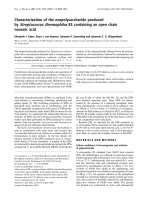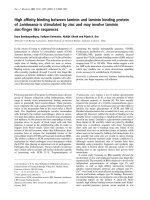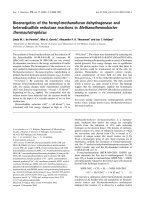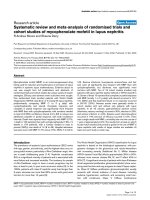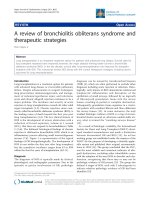Báo cáo y học: "Systematic review: The relation between nutrition and nosocomial pneumonia: randomized trials in critically ill patients" doc
Bạn đang xem bản rút gọn của tài liệu. Xem và tải ngay bản đầy đủ của tài liệu tại đây (215.76 KB, 8 trang )
RESEARC H Open Access
Systematic review: The relation between nutrition
and nosocomial pneumonia: randomized trials in
critically ill patients
Deborah Cook
1
, Bernard De Jonghe
2
, Daren Heyland
3
Abstract
Objective: To review the effect of enteral nutrition on nosocomial pneumonia in critically ill patients as
summarized in randomized clinical trials.
Study identification and selection: Studies were identified through MEDLINE, SCISEARCH, EMBASE, the Cochrane
Library, bibliographies of primary and review articles, and personal files. Through duplicate independent review, we
selected randomized trials evaluating approaches to nutrition and their relation to nosocomial pneumonia.
Data abstraction: In duplicate, independently, we abstracted key data on the design features, population,
intervention and outcomes of the studies.
Results: We identified four trials of enteral vs total parenteral nutrition, one trial of early enteral nutrition vs
delayed enteral nutrition, one trial of gastric vs jejunal tube feeding, one trial of intermittent vs continuous enteral
feeding, and three trials evaluating different enteral feeding formulae. Sample sizes were small, pneumonia
definitions were variable and blinded outcome assessment was infrequent. Randomized trial evidence is insufficient
to draw conclusions about the relation between enteral nutrition and nosocomial pneumonia.
Conclusions: Nutritional interventions in critically ill patients appear to have a modest and inconsistent effect on
nosocomial pneumonia. This body of evidence neither supports nor refutes the gastropulmonary route of infection.
enteral nutrition nosocomial pneumonia, parenteral nutrition, prevention, ventilator-associated pneumonia
Introduction
Nosocomial pneumonia is an important cause of mor-
bidity and mortality in hospitalized patients. Diagnosis
and treatment continues to challenge clinicians and sti-
mulate investigators. Prevention of this serious infection
has been the focus of numerous studies, conferences
and professional documents. Nosocomial pneumonia
prevention strategies may be directed at the ventilator
circuit (frequency of tubing circuit changes and gas
humidification strategies), the endotracheal tube (intuba-
tion orifice, secretion drainage and suctioning) or body
position (kinetic bed thera py and semirecumbancy).
Other nonpulmonary approaches are pharmacologic
(selective digestive decontamination and stress ulcer
prophylaxis) or nutritional (the type, site and timing of
enteral feeds).
The largest numb er of published randomized trials in
intensive care medicine have evaluated selective diges-
tive decontamination and stress ulcer prophylaxis. Five
meta-analyses [1-5] suggest that selective digestive
decontamination confers a large, clinically important
and statistically significant reduction in nosocomial
pneumonia rates (common odds ratio approximately
0.30, 95% CI 0.28–0.48). Nevertheless, selective diges-
tive decontamination is not widely used, in part due to
concern about long-term microbial resistance patterns
and antibiotic costs [6]. Stress ulcer prophylaxis trials
have been recently summarized in a meta-analysis sug-
gesting that sucralfate, as compared with histamine-2-
receptor antagonists or antacids, is associated with a
trend toward a lower rate of nosocomial pneumonia
(common odds ratio 0.78, 95% CI 0.60–1.01) [7].
1
Department of Medicine, Division of Critical Care, St Joseph’s Hospital,
McMaster University, 50 Charlton Avenue East, Hamilton, Ontario L8N 4A6,
Canada
Full list of author information is available at the end of the article
Cook et al. Critical Care 1997, 1:3
/>©1997CurrentScienceLtd
Other experiments show that modifying gastric pH
with acidified e nteral feeds decreases gastric coloniza-
tion, thereby supporting this underlying biologic ratio-
nale [8]. However, sucralfate is not considered of
proven benefit due to the possibility that sucralfate
confers a protective effect only when compared with
gastric pH-altering drugs (which themselves are asso-
ciated with a modest increase in nosocomial pneumo-
nia compared to control) [7].
Kine tic bed therapy has been reviewed in a meta-ana-
lysis of six trials in seriously and critically ill patients,
which indicated a significantly lower rate of pneumonia
and atelectasis in patien ts receiving continuous postur al
oscillation [9]. A less expensive and adaptable pneumo-
nia prevention strategy focussing on body position has
been studied in three random ized trials [10-12]. Torres
et al [10] found that after instillation of radioactive tech-
netium sulfur colloid into the stomach, radioactive
counts in endobronchial secretions were significantly
higher in samples obtained while patients were supine
than when they were semirecumbent. In another study,
scintigraphic evidence of esophageal reflux was found in
81% of patients in the supine position compared to 64%
in the semirecumbent position [11]. Orozco-Levi et al
administered nasogastric technetium sulfur colloid and
found that radioactive counts in en dobronchial secre-
tions increased over time, but were higher in the supine
than the semirecumbent position [12]. Although a cau-
sal relationship between pneumonia and this secondary
endpoint of aspiration of gastric contents has not been
convincingly demonstrated, these trials are in keeping
with the gastropulmonary route of infection.
The gastropulmonary route of infection is a concept at
least two decades old [13], support for which is derived
from multiple human observational studies and experi-
mental evidence [14,15]. Enteral nutrition, c ompared to
parenteral nutrition, is associated with decreased trans-
location in animals and decreased infectious morbidity
in critical illness in humans [16]. Accordingly, it holds
the promise of affording protection against nosocomial
pneumonia. However , enterally feeding critically ill
patients is often associated with intolerance, thereby
predisposing them to aspiration pneumonia. The goal of
this systematic review is to critically appraise and sum-
marize the randomized trials of nutritional strategies
and their influence on nosocomial pneumonia in criti-
cally ill patients.
Methods
Study identification
To identify randomized trials, we searched two compu-
terized databases from 1980 onwards. For MEDLINE,
we used the following text words and keywords: critical
care, intensive c are units, pneumonia, respiratory tract
infection, mechanical ventilation, gastropulmonary, ent-
eral nutrition, randomize d controlled trials, prospective
studies. For EMBASE, we used: pneumonia, prevention,
control. Frequently cited articles were identified and
SCISEARCH (Science Citation Index online) was used
to locate any additional relevant randomized trials. We
also used the Cochrane Library, searching the Clinical
Trials Registry for randomized trials, and the Cochrane
Database of Systematic Reviews (CDSR) as well as the
Datab ase of Abs tracts of Reviews (DARE) for systematic
reviews containing relevant primary studies. We con-
fined our search to studies enrolling non-neutropenic
adult humans without the human immunodeficiency
virus. We had no language restrictions.
The titles (and the abstracts, when available) in the
MEDLINE and EMBASE printouts, and the reference
lists of all primary and review articles were reviewed
independently in duplicate. Any additional relevant arti-
cles were thereby identified and retrieved.
Study selection
The following selection criteria were applied t o the full
manuscripts by two reviewers independently:
1. Population: critically ill adults, including trauma and
burn patients.
2. Interventions: nutritional support.
3. Outcomes: nosocomial pneumonia.
4. Design: published randomized trials in humans.
Apriori, we excluded relevant nutritional interven-
tions in seriously but not necessarily critically ill
patients, studies examining surrogate endpoints for
pneumonia [8], studies which did not report how pneu-
monia was diagno sed [17-19], s tudies which evaluat ed
or reported composite infectious outcomes [20], and
duplicate publications [21].
Study characteristics and data abstraction
Two reviewers abstracted data from the randomized
trials to describe the method of treatment allocation, the
proportion of patients who were e xcluded post-rando-
mization, whether cointerventions were described,
whether the endpoints were assessed by investigators
blinded to the intervention, and the outcome definiti ons
employed. Disagreements between reviewers on design
characteristics and raw data abstraction were resolved
by discussion and consensus.
Analysis
We measured agreement between reviewers on the
selection of articles for inclusion in the review. We stan-
dardized presentation of the randomized trial results
using rel ativ e risk, and calculated 95% confidence inter-
vals using the log transformation method. Since study
questions and trial designs differed, we did not
Cook et al. Critical Care 1997, 1:3
/>Page 2 of 8
statistically pool results of these trials, or subgroups of
them, in a meta-analysis.
Results
Study identification and selection
The search yielded four trials of enteral vs total parent-
eral nutrition [22-25], one trial of early enteral nutrition
vs delayed enteral nutrition [26], one trial of gastric vs
jejunal tube feeding [27], one trial of intermittent vs
continuous enteral feeding [28], and three trials evaluat-
ing different enteral feeding formulae [29-31]. Agree-
ment was 100% for selection of these trials and
systematic reviews.
Study characteristics
Study characteristics are reported in Table 1. Patients
were medical or surgical ICU patients, burn, or trauma
victims. Two studies were explicit about concealment of
randomization using sealed envelopes [26,28]. The nat-
ure of some of these comparisons precluded blinding of
patients and caregivers. Patients were unlikely to be
aware of the details of their care and were not partici-
pating in assessment of the presence of nosocomial
pneumonia. However, lack of blinding could have
affected the care delivered by bedside nurses, respiratory
therapists and intensivists, which could have affected the
development of lung infection. In one trial, the neuro-
surgeon evaluating outcomes was blinded [22]; in
another, confirmation of outcome was conducted by a
second blinded surgeon [24]. Two of the three studies
comparing different feeding products employed blinded
outcome assessment [29,31].
Cointerventions are interventions which are unrelated
to the study question, yet may impact on the outcome,
and could be unequally distributed across groups. These
include stress ulcer prophylaxis and selectiv e digestive
decontamination (Table 1). Other cointerventions not
mentioned, but potentially important to standardize or
report, might include chest physiotherapy and position
of the patients.
In two trials, the pneumonia definition incorpor ated
butdidnotrequireinvasivebronchoscopic techniques
[24,28]; in a third trial, a positive bronchoalveolar lavage
was required for the diagnosis [31].
Study results
The results of these randomized trials are presented in
Table 2. The four trials evaluating total parenteral vs
enteral nutrition yield inconsistent results. In one, there
was a trend toward a lower rate of pneumonia asso-
ciated with enteral nutrition [23], in another study the
pneumonia rate was significantly lower in the enteral
nutrition group [24], and in the remaining two studies,
the pneumonia rate was slightly higher in patients
receiving enteral nutrition [22,25].
One study examined early enteral nasoduodenal nutri-
tion begun within 24 h vs nasoduodenal enteral nutri-
tion delayed for 72 h. In patients receiving early feeds,
there was a trend toward increased pneumonia (8/19 vs
4/19, respectively) [26].
Considering the potential for enteral nutrition to
cause aspiration pneumonia, one study tested the effect
of proximal vs distal delivery sites [27]. Two cases of
pneumonia were identified amongst those 19 patients
receiving prepyloric gastric feeds and no cases were
observed in the 19 patients receiving post-pyloric feeds
through a jejunal tube.
To avoid continuous alkalinization and intragastric
Gram-negative growth associated with enteral feeding,
intermittent enteral nutrition was compared with con-
tinuous enter al nutrition i n one trial [28]. Five of
30 patients in each group developed nosocomial
pneumonia.
Three studies examined different enteral feeding for-
mulae and their relation to lung infection. The first com-
pared modular tube feeds (a high protein, low fat, linoleic
acid-restricted formulation enhanced with arginine,
cysteine, vitamin A, zinc, omega-3-polyunsaturated fatty
acids, and ascorbic acid) against Osmolite and Traumacal
and found a trend toward lower pneumonia rates in the
modular tube feed patients [29]. There was no difference
in pneumonia between trauma patients fed Immun-Aid
(containing glutamine, arginine, omega-3-polyunsa tu-
rated fatty acids, nucleotides, and bran ched chain amino-
acids) vs Vivonex (standard enteral formulae) [30].
In another study of trauma patients, Immun-Aid was
associated with a trend toward a lower pneumonia rate
than patients fed with Promote (an isonitrogenous, isoca-
loric diet) [31].
Discussion
The results of these 10 trials of feeding strategie s, either
individually or in aggregate, provide i nconclusive evi-
dence about the relation between enteral nutrition and
nosocomial pneumonia. These studies enrolled a total of
582 patients and contribute 117 cases of pneumonia.
The single trial showing a significantly lower pneumonia
rate associated with jejunal enteral nutrition over par-
enteral nutrition [24] has not been translated into wide-
spread clinical policy, perhaps due to the inconvenience
and expertise required for jejunostomy tubes. Aside
from concerns about type I and II error when interpret-
ing the trials in this review, there are other relevant out-
comes addressed by some, but not all of these studies,
including effects on nutritional markers and adverse
outcomes such as catheter sepsis and patient comfort.
Cook et al. Critical Care 1997, 1:3
/>Page 3 of 8
Table 1 Nutrition and nosocomial pneumonia: study characteristics
Author
[reference]
Intervention Population Allocation Cointerventions Exclusion post- Blinding of Definition of
randomization outcome
accessor
VAP
Young et al [22] Nasogastric Head injury `Was randomly All patients
received
7 Exclusions: Neurosurgen Infiltrate and
enteral
nutrition
patients assigned to’ prokinetic 5-early death, 2 evaluating leukocytosis
vs total -withdrew outcomes was premature cells,
parenteral blinded fever, positive
nutrition sputum culture
Moore et al [23] Enteral
nutrition
Trauma
patients
`Randomized by Broad spectrum No exclusions: Outcome New infiltrate and
via needle requiring computer antibiotics to both 4-early death, assessment
not
fever, leukocytosis
catheter emergency assignment’ groups 3-reoperation, blinded and purulent
jejunostomy
vs
celiotomy 3-chronic illness, sputum
total
parenteral
2-ATI> 40,
nutrition 2-head injury,
1-mechanical
failure,
1-transfer
Kudsk et al [24] Enteral
nutrition
Patients with
blunt
`Computer NR 2 Exclusions: Secondary New infiltrate and
via needle and
penetrating
generated death within 4 confirmation
of
leukocytosis,
jejunostomy
vs
abdominal
trauma
randomization days outcome by positive sputum or
total
parenteral
table’ blinded
surgeon
BAL, or purulent
nutrition sputum
Borzotta et al [25] Enteral
nutrition
Patients with `Computer Jejunostomy
group
NR Outcome Infiltrate and
via needle severe closed
head
generated
random
had gastrostomy assessment
not
fever, leukocytosis,
catheter injury number tube drainage blinded leukorrhea and
jejunostomy
vs
assignment’ bacteria on Gram
total
parenteral
stain
nutrition
Eyer et al [26] Early (<24 h) Patients with
blunt
`Randomization
by
All patients
received
14 Exclusions: Outcome New infiltrate and
nasoduodenal abdominal
trauma
card drawn
from
either sucralfate or 3-regular diet, assessment
not
significant growth
tube feeding
vs
sealed
envelope’
antacids but group
not
3-steroids, blinded on sputum
Cook et al. Critical Care 1997, 1:3
/>Page 4 of 8
Table 1 Nutrition and nosocomial pneumonia: study characteristics (Continued)
late (>72 h) specified 2-no NGT, culture with <10
nasoduodenal 6-miscellaneous epithelial cells,
tube feeding >25 wbc/hpf OR
purulent
secretions, fever
and leukocytosis
Montecalvo et al
[27]
Gastric vs
jejunal
Medical and `Randomly 25 Patients
received
5 Patients
crossed
Cultures New and
tube feeding surgical ICU assigned sucralfate; 1 H
2
RA; over from
jejunal to
reviewed
blinded
persistent
patients according to 2 H
2
RA and
antacids;
gastric group
and
to group infiltrate and
computer 8 sucralfate and 2 patients
crossed
assignment three of: purulent
generated
random
either H
2
RA or over from
gastric
sputum with
number code’ antacids; 1 no
stress
to jejunal
group;
numerous
ulcer prophylaxis,
but
these 7 patients bacteria, purulent
group not
specified
were included
until
sputum with
the day they nosocomial
crossed over pathogen, T>38
6
,
or wbc >10
Bonten et al [28] Intermittent Mixed ICU `Randomization Intermittent: 13- None Outcome New and
enteral
feeding
patients and was performed antacids and 17- assessment
not
persistent
(18 h) vs cardiac surgery with sealed sucralfate; blinded infiltrate and 3 of:
continuous patients
needing
envelopes’ continuous: 7 - T>38 or T<35
5
enteral
feeding
ventilation > 3 antacids and 23 - OR wbc > 10
(24 h) days sucralfate and/or left shift
or wbc < 3 OR 10
wbc/hpf on ET
Gram strain OR
positive ET
aspirate and one
of these: BAL
(positive if > 10
4
CFU/ml) OR
PSB (positive if
>10
3
CFU/ml)
OR positive
blood culture OR
positive pleural
culture
Cook et al. Critical Care 1997, 1:3
/>Page 5 of 8
Readers are referred to the original articles for these
important details.
Factors such a s cost, and ease with which the feeding
strategy can be employed, are additional issues that bear
on the interpretation and application of these trial
results in practice. Intensivists also consider evidence
from observational studies when making clinical deci-
sions. Given these provisos, it is not surprising that defi-
nitive statements about enteral nutrition and lung
infection are not forthcoming. Some guidelines from the
Center for Disease Control on the prevention of nosoco-
mial pneumonia [32] f ocus on gastrop ulmonary
approaches. Stress u lcer prophylaxis with an agent that
does not increase gastric pH was `suggested for
implementation in many hospitals and supported by
suggestive clinical and epidemiologic studies and a
strong theoretical rationale’. Other interventions labelled
as `unresolved for which no recommendations were
made’ included jejunal feeding, intermittent enteral feed-
ing a nd selective digestive decontamination. In the
American Thoracic Society s tatemen t on preve ntion of
hospital-acquired pneumonia in adults [33], some pro-
phylactic interventions were classified as having `prob-
able effectiveness, used widely in some clinical settings’,
such as distal enteral nutrition, semi-erect positioning,
and sucralfate. Selective digestive decontamination was
considered `of unproven value used on a limited investi-
gational or clinical basis’.
Table 1 Nutrition and nosocomial pneumonia: study characteristics (Continued)
Gottsschlich et al
[29]
Modular tube Burn patients `Random
number
NR NR Physicians, Infiltrate and
feeding vs
two
(>10% BSA) table stratified
for
nurses, positive sputum
standard
enteral
age, center and technicians, culture and
feeding burn size’ clinical and systemic
(Osmolite vs research antibotics
Traumacal) personnel
were
blinded
Moore et al [30] Early enteral Trauma
patients
`Randomized by
a
NR 16 exclusions: Outcome New and
immune- computer- 9-inappropriate assessment
not
progressive
enhancing generated randomizations, blinded infiltrate, fever,
feeding vs schedule’ 7-drop -outs leukocytosis,
standard
enteral
1-early death positive sputum
feeding Gram stain with
(Vivonex) many polys
Kudsk et al [31] Early
immune-
Trauma
patients
`Computer- Short-term broad NR All caregivers New or changing
enhancing requiring generated spectrum
antibiotics
blinded
except
infiltrate and
feeding via emergency randomization to both groups nutritionist fever,
jejunostomy
vs
celiotomy table’ leukocytosis,
standard
enteral
purulent sputum
feeding underwent BAL
(Promote) (positive if > 10
3
CFU/hpf)
Abbreviations: ATI=acute trauma index; BAL=bronchoalveolar lavage; NGT=nasogastric tube; wbc=white blood cells; hpf=high power field; H
2
RA=histamine-2-
receptor antagonists; ET=endotracheal; CFU=colony forming units; BSA=body surface area; NR=not reported; VAP=ventilator-associated pneumonia;
PSB=protected specimen brush.
Cook et al. Critical Care 1997, 1:3
/>Page 6 of 8
Nutrition is integral to the care of an ICU patient.
The method, site and timing of enteral nutrition may
have a protective or predisposing influence on the risk
of nosocomial infection [34], though strong proof from
experimentsinhumansdoesnotcurrentlyexist.
Although a meta-analysis of published and unpub-
lished trials of general surgical and trauma pat ients
suggested a low er pneumonia rate in patients rece iving
enteral nutrition vs total parenteral nutrition [35],
published data from ventilated medical ICU patients
are sparse, and generalizing to other populations may
not be reasonable. Interventions requiring further
investigation with large rigorous studies of ICU
patients include those discussed in this review, as well
as the size of feeding tubes [36], their insertion site,
where the tubes are located in the gastrointestinal
tract [37], f eeding advancement schedules, and the
effect of prokinetic drugs [38].
Table 2 Results of randomized trails of nutrition and nosocomial pneumonia
Intervention (author [reference]) Pneumonia rates Relative risk (95% Cl)
Nasogastric enteral nutrition vs parenteral nutrition (Young [22]) TPN: 6/23 (26%) 1.23 (0.51–2.95)
EN: 9/28 (32%)
Jejunostomy feeding vs total parenteral nutrition (Moore [23]) TPN: 6/30 (20%) Undefined
EN: 0/29 (0%)
Jejunostomy feeding vs total parenteral nutrition (Kudsk [24]) TPN: 14/45 (31%) 0.38 (0.16–0.90)
EN: 6/51 (12%)
Jejunostomy feeding vs total parenteral nutrition (Borzotta [25]) TPN: 9/23 (39%) 1.06 (0.56–2.02)
EN: 15/36 (42%)
Early nasoduodenal vs late nasoduodenal feeding (Eyer [26]) Late: 4/19 (21%) 2.00 (0.72–5.54)
Early: 8/19 (42%)
Jejunal vs gastric feeding (Montecalvo [27]) Gastric: 2/19 (11%) Undefined
Jejunal: 0/19 (0%)
Intermittent enteral feeding vs continuous enteral feeding (Bonten [28]) CEF: 5/30 (17%) 1.0 (0.32–3.10)
IEF: 5/30 (17%)
Modular tube feeding (MTF) vs Osmolite vs Traumacal (Gottschlich [29]) Osmolite: 6/14 (43%) 0.27 (0.07–1.15)
*
Traumacal: 9/19 (47%) 0.25 (0.06-0.99)
†
MTF: 2/17 (12%)
Immun-Aid vs Vivonex (Moore [30]) Vivonex: 4/47 (9%) 0.92 (0.24–3.48)
Immun-Aid: 4/51 (8%)
Immun-Aid vs Promote (Kudsk [31]) Promote: 3/17 (18%) Undefined
Immun-Aid: 0/16 (0%)
Abbreviations: EN = enteral nutrition; TPN = total parenteral nutrition; CEF = continuous enteral feeding; IEF = intermittent enteral feeding.
*
Osmolite compared
to MTF.
†
Traumacal compared to MTF.
Cook et al. Critical Care 1997, 1:3
/>Page 7 of 8
Acknowledgements
We would like to thank Barbara Hill for her help with the manuscript
preparation and Lauren Griffith for her help with the analyses.
Author details
1
Department of Medicine, Division of Critical Care, St Joseph’s Hospital,
McMaster University, 50 Charlton Avenue East, Hamilton, Ontario L8N 4A6,
Canada.
2
Service de Réanimation Medicale, Hôpital de Poissy, Poissy, France.
3
Department of Medicine, Division of Critical Care, Queen’s University,
Kingston, Ontario, Canada.
Received: 27 June 1997 Published: 13 August 1997
References
1. Vandenbrouke CM, Vandenbrouke JP: Effect of selective decontamination
of the digestive tract on respiratory tract infections and mortality in the
intensive care unit. Lancet 1991, 338:859-862.
2. Selective Decontamination of the Digestive Tract Trialist’s Collaborative
Group : Meta-analysis of randomized controlled trials of selective
decontamination of the digestive tract. Br Med J 1993, 307:525-532.
3. Kollef MH: The role of selective digestive tract decontamination on
mortality and respiratory infections: a meta-analysis. Chest 1994,
105:1101-1108.
4. Heyland DK, Cook DJ, Jaeschke RZ, Griffith LE, Lee HN, Guyatt GH: Selective
decontamination of the digestive tract: an overview. Chest 1994,
105:1221-1229.
5. Hurley JC: Prophylaxis with enteral antibiotics in ventilated patients:
selective decontamination or selective cross-infection? Antimicrob Agents
Chemother 1995, 39:941-947.
6. Verwaest C, Verhaegen J, Ferdinande P, et al: Randomized controlled trial
of selective digestive decontamination in 600 mechanically ventilated
patients in a multidisciplinary intensive care unit. Crit Care Med 1997,
25:63-71.
7. Cook DJ, Reeve BK, Guyatt GH, et al: Stress ulcer prophylaxis in critically ill
patients: resolving discordant meta-analyses. JAMA 1996, 275:308-314.
8. Heyland DK, Bradley C, Mandell LA: Effect of acidified enteral feedings on
gastric colonization in the critically ill patient. Crit Care Med 1992,
20:1388-1394.
9. Choi SC, Nelson LD: Kinetic therapy in critically ill patients: combined
results based on meta-analysis. J Crit Care 1992, 79:57-62.
10. Torres A, Serra-Battles J, Ros E, et al: Pulmonary aspiration of gastric
contents in patients receiving mechanical ventilation: the effect of body
position. Ann Intern Med 1992, 116:540-543.
11. Ibanez J, Penafiel A, Raurich JM, Marse P, Jorda R, Mata F:
Gastroesophageal reflux in intubated patients receiving enteral
nutrition: effect of supine and semirecumbent positions. J Parent Enteral
Nutr 1992, 16:419-422.
12. Orozco-Levi M, Torres A, Ferrer M, et al: Semirecumbent postion protects
from pulmonary aspiration but not completely from gastroesophageal
reflux in mechanically ventilated patients. Am J Resp Crit Care Med 1995,
152:1387-1390.
13. Atherton ST, White DJ: Stomach as source of bacteria colonizing
respiratory tract during artificial respiration. Lancet 1978, ii:1968-1971.
14. Heyland D, Mandell LA: Gastric colonizaiton by Gram-negative bacilli and
nosocomial pneumonia in the intensive care unit patient: evidence for
causation. Chest 1992, 101:87-93.
15. Bonten MJM, Gaillard CA, de Leeuw PW, Stobberingh EE: Role of
colonization of the upper intestinal tract in the pathogenesis of
ventilator associated pneumonia. Clin Infect Dis 1997, 24:309-319.
16. Heyland D, Cook DJ, Guyatt GH: Enteral nutrition in the critically ill
patient: a critical review of the evidence. Intensive Care Med 1993,
19:435-442.
17. Hadley MN, Grahm TW, Harrington T, Schiller WR, McDermott MK,
Posillico DB: Nutritional support and neurotrauma: a critical review of
early nutrition in forty-five acute head injured patients. Neurosurgery
1986, 19:367-373.
18. Adams S, Dellinger EP, Wertz MJ, Oreskovich MR, Simonowitz D,
Johansen KAJ: Enteral versus parenteral nutritional support following
laparatomy for trauma: a randomized prospective trial. J Trauma 1986,
26:882-891.
19. Moore EE, Jones TN: Benefits of immediate jejunostomy feeding after
major abdominal trauma — a prospective, randomized study. J Trauma
1986, 26:874-881.
20. Bower RH, Cerra FB, Bershadsky B, et al: Early enteral administration of a
formula (Impact) supplemented with arginine, nucleotides, and fish oil
in intensive care unit patients: results of a multicenter, prospective
randomized clinical trial. Crit Care Med 1995, 23:436-449.
21. Kudsk KA: Gut mucosal nutritional support: enteral nutrition as primary
therapy after multiple system trauma. Gut 1994, 35 (suppl 1):S52-S54.
22. Young B, Ott L, Twyman D, et al: The effect of nutritional support on
outcome from severe head injury. J Neurosurg 1987, 67:668-676.
23. Moore FA, Moore EE, Jones TN, McCroskey BL, Peterson VM: TEN versus
TPN following major abdominal trauma — reduced septic morbidity. J
Trauma 1989, 29:916-923.
24. Kudsk KA, Croce MA, Fabian TC, et al: Enteral versus parenteral feeding:
effects on septic morbidity after blunt and penetrating abdominal
trauma. Ann Surg 1992, 215:503-511.
25. Borzotta AP, Pennings J, Papasadero B, et al:
Enteral versus parenteral
nutrition after severe closed head injury. J Trauma 1994, 373:459-468.
26. Eyer SD, Micon LT, Konstantinides FN, et al: Early enteral feeding does not
attenuate metabolic response after blunt trauma. J Trauma 1993,
34:639-644.
27. Montecalvo MA, Steger KA, Farber HW, et al: Nutritional outcome and
pneumonia in critical care patients randomized to gastric versus jejunal
tube feedings. Crit Care Med 1992, 20:1377-1387.
28. Bonten MJ, Gaillard CA, van der Hulst R, et al: Intermittent enteral feeding:
the influence on respiratory and digestive tract colonization in
mechanically ventilated intensive-care-unit patients. Am J Respir Crit Care
Med 1996, 154:394-399.
29. Gottschlich MM, Jenkins M, Warden GD, et al: Differential effects of three
enteral dietary regimens on selected outcome variables in burn
patients. J Parenter Enteral Nutr 1990, 14:225-236.
30. Moore FA, Moore FF, Kudsk KA, et al: Clinical benefits of an immune-
enhancing diet for early postinjury enteral feeding. J Trauma 1994,
37:607-614.
31. Kudsk KA, Minard G, Croce MA, et al: A randomized trial of isonitrogenous
enteral diets after severe trauma: an immune-enhancing diet reduces
septic complications. Ann Surg 1996, 224:531-543.
32. Tablan OC, Anderson LJ, Arden N, Breiman RF, Butler JC, McNeil MM:
Guideline for prevention of nosocomial pneumonia. Part I. Issues on
prevention of nosocomial pneumonia. Am J Infect Control 1994,
22:247-292.
33. American Thoratic Society Ad Hoc Committee of the Scientific Assembly on
Microbiology, Tuberculosis and Pulmonary Infections : Hospital-acquired
pneumonia in adults: diagnosis, assessment of severity, initial
antimicrobial therapy and preventive strategies: a consensus statement.
Am J Resp Crit Care Med 1995, 153:1711-1725.
34. Heyland DK, Cook DJ, Guyatt GH: Does the formulation of enteral feeding
products influence infectious morbidity and mortality in the critically ill
patient? A critical review of the evidence. Crit Care Med 1994,
22:1192-1202.
35. Moore FA, Feliciano DV, Andrassy RJ, et al: Early enteral feeding compared
with parenteral reduces postoperative septic complications. The results
of a meta-analysis. Ann Surg 1992, 216:172-183.
36. Metheny NA, Eisenberg P, Spies M: Aspiration pneumonia in patients fed
through nasoenteral tubes. Heart Lung 1986, 15:256-261.
37. Strong RM, Condon SC, Solinger MR, Namihas BN, Ito-Wong LA, Leuty JE:
Equal aspiration rates from post-pylorus and intragastric-placed small-
bore nasoenteric feeding tubes: a randomized, prospective study. J
Parenter Enteral Nutr 1992, 16:59-63.
38. Heyland DK, Tougas G, Cook DJ, Guyatt GH: Cisapride improves gastirc
emptyting in mechanically ventilated critically ill patients: a randomized
double-blind trial. Am J Resp Crit Care Med 1996, 154:1678-1683.
doi:10.1186/cc1
Cite this article as: Cook et al.: Systematic review: The relation between
nutrition and nosocomial pneumonia: randomized trials in critically ill
patients. Critical Care 1997 1:3.
Cook et al. Critical Care 1997, 1:3
/>Page 8 of 8
